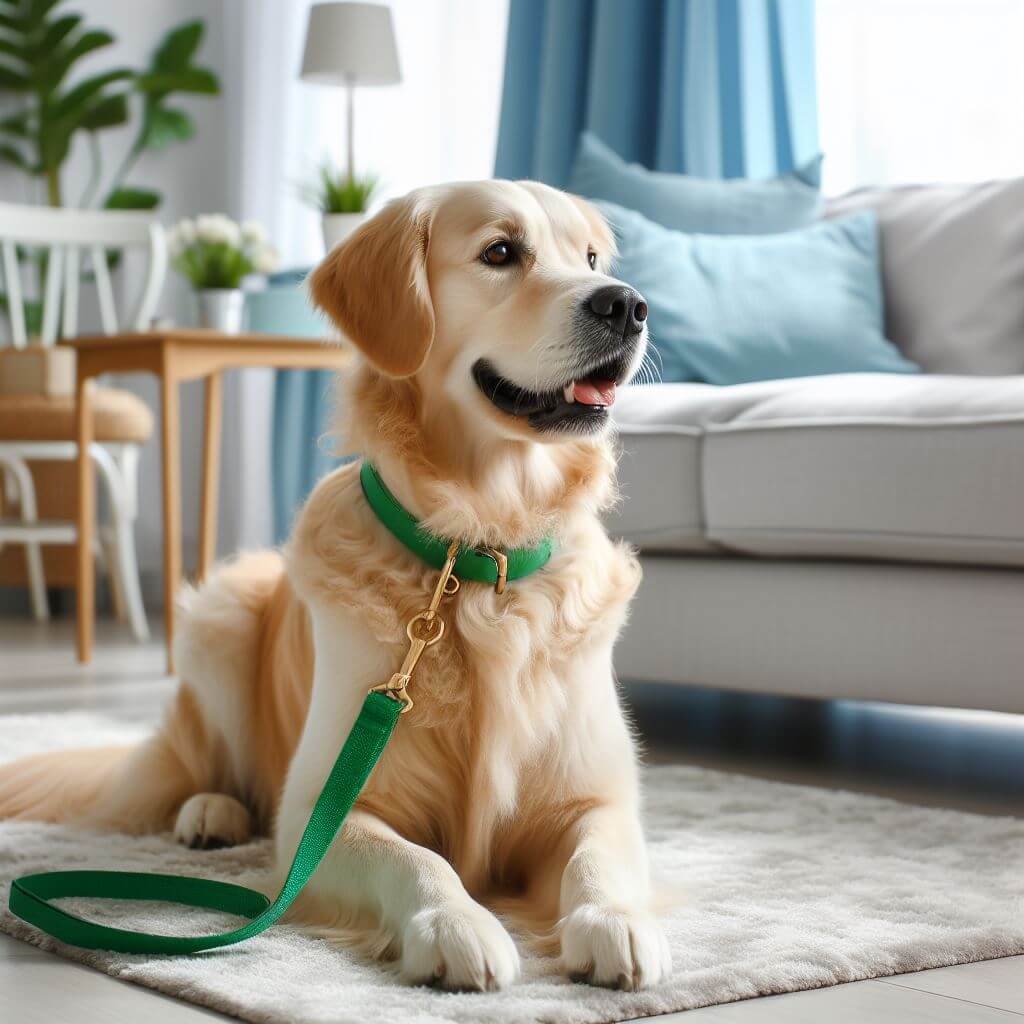The world of dog owners’ debates and concerns is opened up, and the query lingers: ‘Should I keep my dog on a leash in the house?’ It’s a topic that fuels discussions, stirring varied opinions and sparking curiosity. For many, the idea of leashing a furry companion indoors might seem peculiar, even unnecessary.
However, delving into this seemingly unconventional practice reveals a myriad of reasons, considerations, and potential benefits that might just surprise you.
Yes, it is generally recommended to keep your dog on a leash in the house for training and safety purposes.
should I keep my dog on a leash in the house
Yes, keeping a dog on a leash in the house can be beneficial in certain situations. It offers safety, aids in training, and can manage behavioral issues effectively.
Leashing indoors isn’t about confinement but about safety, especially for puppies, newly adopted dogs, or those in training. It prevents accidents, reinforces boundaries, and aids in teaching commands. For dogs with behavioral issues or anxiety, a leash offers a sense of security and controlled guidance. However, it’s crucial to balance it with ample exercise and free-roaming time to maintain their mental and physical well-being.

Why Keep Your Dog on a Leash in the House?
Keeping your dog on a leash indoors fosters safety, aids in training, and manages behavior effectively.

Safety indoors might seem redundant, yet it’s crucial, especially for young dogs prone to mischief or those undergoing training. It helps in teaching boundaries, reinforces commands, and prevents accidents. Leashing serves as a tool for behavioral correction, assisting in redirecting unwanted actions and ensuring a controlled environment. Additionally, for dogs with separation anxiety or excessive energy, a leash indoors can provide comfort and structure, reducing stress and promoting a sense of security.
- dog lead vs leash
- will a coyote attack a dog on a leash
- transitional leash
- is it illegal to walk your dog without a leash
- will a hawk attack a dog on a leash
- Off Leash Dog Bar
Benefits of Keeping Your Dog on a Leash In the House
While the idea of leashing your dog indoors may seem unconventional, its benefits are significant. Understanding why keeping your furry companion on a leash within the confines of your home can be advantageous sheds light on the safety, training, and overall well-being of your beloved pet.
- Safety First: Prevents accidents, especially for puppies and high-energy dogs prone to running into household hazards.
- Training Aid: Reinforces training commands, boundaries, and behavioral expectations in a controlled setting.
- Behavior Management: Assists in curbing undesirable behaviors like jumping, chewing, or excessive barking.
- Anxiety Reduction: Provides a sense of security for anxious dogs, promoting calmness and reducing stress.
- Bonding Opportunity: Enhances the bond between you and your furry friend through shared indoor activities and focused interaction.
- Protection from Unwanted Behaviors: Leashing your dog indoors helps in curbing undesirable behaviors such as jumping, chewing furniture, or excessive barking by offering immediate correction and guidance.
- Limiting Access to Areas of the Home: It allows you to control where your dog goes, preventing them from entering restricted or potentially hazardous areas within your house.
- Establishing Structure and Boundaries: A leash indoors sets clear boundaries, teaching your dog what areas are off-limits and reinforcing the notion of indoor boundaries.
- Preventing Accidents or Injuries indoors: By keeping your dog on a leash, you can minimize the chances of accidents or injuries, especially for younger or more excitable dogs who might dash around unpredictably.
- Making it Easier to Train Your Dog at Home: Leashing provides a controlled environment for training sessions, enabling focused attention and reinforcing obedience commands effectively within the home setting.
House Leash For Dogs
Discover the variety of indoor leashes tailored for your dog’s comfort and your convenience. From standard six-foot leashes to hands-free cord options, each type serves a unique purpose. Let’s explore these indoor leash variations and their suitability for different scenarios.
| Leash Type | Description | Suitability |
| Standard Six-foot Leashes | Fixed-length leashes typically measuring six feet, providing control and stability. | Ideal for basic obedience training and maintaining control during indoor walks. |
| Retractable Leashes | Adjustable-length leashes that offer flexibility for varying distances within the home. | Useful for allowing more freedom of movement while maintaining control indoors. |
| Hands-Free Umbilical Cord Leashes | Leashes designed to be worn around the waist, offering a hands-free experience indoors. | Great for multi-tasking while training or bonding with your dog indoors. |
Cautions To Consider When Using A Leash In The House
Leashing your dog indoors can offer numerous benefits, yet certain precautions are essential to ensure a positive experience:
- Tangle Hazards: Watch for potential tangles around furniture or objects that could cause discomfort or accidents.
- Supervision: Always supervise your dog while leashed indoors to prevent entanglement or accidental injuries.
- Avoiding Excessive Restraint: Ensure the leash length isn’t too short to restrict movement or cause discomfort to your dog.
- Selecting the Right Leash: Choose an appropriate leash type and length to suit your dog’s size, breed, and behavior.
- Training Gradually: Introduce indoor leashing gradually to accustom your dog, avoiding stress or anxiety.
Restrictions On Lengths Of Time Or Periods Of Use
Leashing your dog indoors brings benefits, but it’s essential to consider limitations:
- Supervision is Key: Avoid leaving your dog leashed and unsupervised to prevent potential accidents or entanglement.
- Balanced Usage: Use leashes indoors during training or specific activities, balancing it with free-roaming time.
- Comfort Consideration: Regularly check for any signs of discomfort or irritation caused by prolonged leash use.
- Behavioral Assessment: Evaluate if continuous leashing indoors affects your dog’s behavior or mental well-being.
Remember, while useful, leashing indoors should be balanced with adequate supervision and consideration for your dog’s comfort and behavior.
Potential Health Risks From Inappropriate Use
Leashing your dog indoors can offer numerous benefits, yet improper or excessive use of a leash may pose certain health risks to your furry friend.
Health Risks:
- Neck and Throat Injuries: Constant pressure on the neck from pulling or sudden movements on a leash can lead to injuries, including tracheal damage or neck strain.
- Restricted Movement: Prolonged confinement to a leash indoors might limit your dog’s natural movement, potentially causing stiffness, muscle atrophy, or joint issues.
- Behavioral Stress: Overuse of a leash indoors without adequate breaks or freedom may induce stress, anxiety, or frustration, impacting your dog’s mental well-being.
- Skin and Coat Issues: Continuous contact with a leash can cause skin irritation, abrasions, or fur matting, particularly in sensitive-skinned or long-haired breeds.
- Risk of Entanglement: Inappropriately sized or tangled leashes can pose a risk of entanglement, leading to accidents or injury while moving indoors.
Is It Okay To Leash A Puppy
Absolutely! Leashing a puppy, when done appropriately, can be beneficial for their safety and training. However, it’s crucial to consider the following factors:
- Proper Equipment: Ensure you use a lightweight, appropriately sized leash and harness to prevent discomfort or injury to the puppy’s delicate neck.
- Gradual Introduction: Introduce the leash gradually, associating it with positive experiences, treats, and play to help the puppy adjust comfortably.
- Supervision and Limitation: Use the leash under supervision and avoid prolonged use, allowing the puppy free time to explore and play without restraint.
- Training Opportunity: Leashing offers a chance to start basic training, teaching commands like ‘heel’ or ‘come’ and establishing boundaries early on.
- Consultation with a Vet or Trainer: Seek advice from a veterinarian or professional trainer for guidance on appropriate leash use based on your puppy’s breed, age, and behavior.
In essence, with proper handling and guidance, leashing a puppy can aid in their safety, training, and the development of positive behaviors.
Is it OK to keep dog on leash at night?
Yes, it can be okay to keep a dog on a leash at night for safety or training purposes, but it requires careful consideration and monitoring.”

Nighttime leashing can aid in training or if you’re camping or staying in unfamiliar places. Safety concerns or a dog’s restlessness may also necessitate this practice. Yet, it’s vital to ensure comfort, use a comfortable leash, and maintain supervision. Avoid prolonged leashing, prioritize comfort, and consider alternatives like crate training or creating a safe sleeping area to promote relaxation and security.
Frequently asked Questions (Faq)
Is it good to leash your dog at home?
Leashing your dog at home can be beneficial in specific situations, aiding in training, managing behavior, and ensuring safety, especially for young pups or during training sessions. However, it’s essential to balance leashed time with off-leash freedom indoors.
Should I keep a leash on my dog at all times?
Keeping a leash on your dog at all times isn’t necessary. While leashing indoors can be helpful for training and safety, dogs also need off-leash time for exercise, mental stimulation, and freedom to explore within a safe environment.
Should dogs ever be off-leash?
Yes, dogs should have off-leash time in safe, designated areas. Off-leash activities, when done responsibly, allow dogs to exercise, socialize, and explore freely, contributing positively to their overall well-being and happiness.
Do dogs enjoy being off-leash?
Generally, yes! Dogs often revel in the freedom and opportunities for exploration that come with being off-leash. It allows them to engage their instincts, socialize with other dogs, and experience a sense of liberation and joy.
Conclusion:
In the end, the decision to keep your dog on a leash indoors hinges on individual circumstances. While it might seem unconventional, it can offer safety, aid in training, and manage behavioral concerns effectively. Understanding your dog’s needs, their behavior, and the environment is crucial. Leashing indoors isn’t about restriction but about ensuring their well-being.
So, consider the balance, assess the necessity, and remember, ‘Should I keep my dog on a leash in the house?’—the answer lies within your unique situation.


